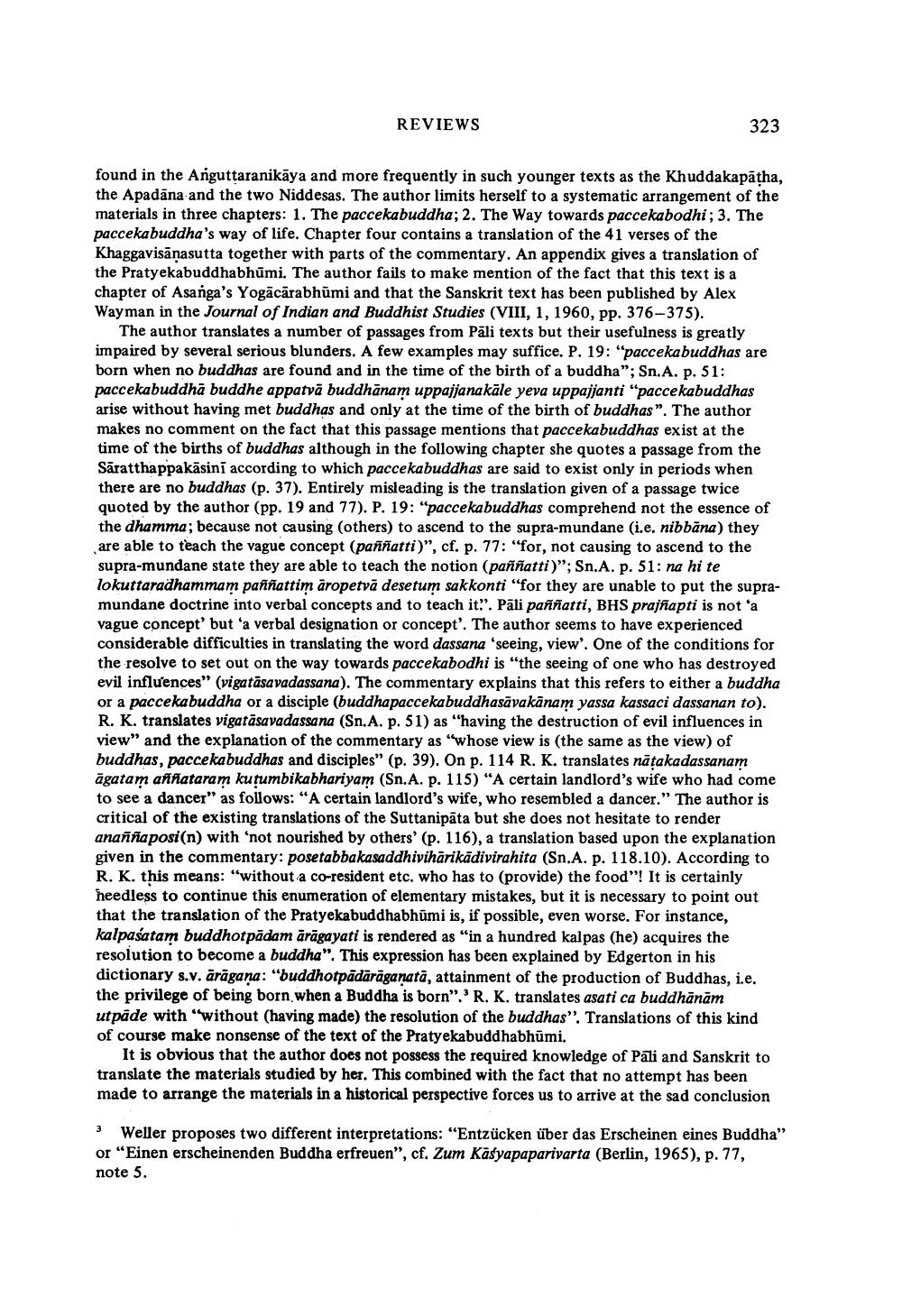________________
REVIEWS
323
found in the Arguttaranikāya and more frequently in such younger texts as the Khuddakapātha, the Apadāna and the two Niddesas. The author limits herself to a systematic arrangement of the materials in three chapters: 1. The paccekabuddha; 2. The Way towards paccekabodhi; 3. The paccekabuddha's way of life. Chapter four contains a translation of the 41 verses of the Khaggavisānasutta together with parts of the commentary. An appendix gives a translation of the Pratyekabuddhabhūmi. The author fails to make mention of the fact that this text is a chapter of Asanga's Yogācārabhūmi and that the Sanskrit text has been published by Alex Wayman in the Journal of Indian and Buddhist Studies (VIII, 1, 1960, pp. 376-375).
The author translates a number of passages from Pāli texts but their usefulness is greatly impaired by several serious blunders. A few examples may suffice. P. 19: "paccekabuddhas are born when no buddhas are found and in the time of the birth of a buddha"; Sn. A. p. 51: paccekabuddha buddhe appatvā buddhānam uppajjanakale yeva uppajjanti "pacce kabuddhas arise without having met buddhas and only at the time of the birth of buddhas". The author makes no comment on the fact that this passage mentions that pacce kabuddhas exist at the time of the births of buddhas although in the following chapter she quotes a passage from the Sāratthappakäsini according to which paccekabuddhas are said to exist only in periods when there are no buddhas (p. 37). Entirely misleading is the translation given of a passage twice quoted by the author (pp. 19 and 77). P. 19: "paccekabuddhas comprehend not the essence of the dhamma; because not causing (others) to ascend to the supra-mundane (i.e. nibbāna) they are able to teach the vague concept (paññatti)", cf. p. 77: "for, not causing to ascend to the supra-mundane state they are able to teach the notion (paññatti)”; Sn.A. p. 51: na hi te lokuttaradhammam paññattim aropetvā desetum sakkonti "for they are unable to put the supramundane doctrine into verbal concepts and to teach it."'. Pāli paññatti, BHS prajñapti is not a vague concept' but 'a verbal designation or concept'. The author seems to have experienced considerable difficulties in translating the word dassana 'seeing, view'. One of the conditions for the resolve to set out on the way towards paccekabodhi is "the seeing of one who has destroyed evil influences" (vigatāsavadassana). The commentary explains that this refers to either a buddha or a paccekabuddha or a disciple (buddhapaccekabuddhasāvakānam yassa kassaci dassanan to). R. K. translates vigatāsavadassana (Sn.A. p. 51) as "having the destruction of evil influences in view" and the explanation of the commentary as "whose view is (the same as the view) of buddhas, paccekabuddhas and disciples" (p. 39). On p. 114 R. K. translates nātakadassanam āgatam annataram kutumbikabhariyam (Sn. A. p. 115) "A certain landlord's wife who had come to see a dancer" as follows: "A certain landlord's wife, who resembled a dancer." The author is critical of the existing translations of the Suttanipāta but she does not hesitate to render anañña posi(n) with 'not nourished by others' (p. 116), a translation based upon the explanation given in the commentary: posetabbakasaddhiviharikādivirahita (Sn.A. p. 118.10). According to R. K. this means: "without a co-resident etc. who has to provide the food"! It is certainly heedless to continue this enumeration of elementary mistakes, but it is necessary to point out that the translation of the Pratyekabuddhabhūmi is, if possible, even worse. For instance, kalpasatam buddhotpadam ārāgayati is rendered as "in a hundred kalpas (he) acquires the resolution to become a buddha". This expression has been explained by Edgerton in his dictionary s.v. ārāgana: "buddhotpadārāganatā, attainment of the production of Buddhas, i.e. the privilege of being born when a Buddha is born".'R. K. translates asati ca buddhānām utpäde with "without (having made) the resolution of the buddhas". Translations of this kind of course make nonsense of the text of the Pratyekabuddhabhūmi.
It is obvious that the author does not possess the required knowledge of Pali and Sanskrit to translate the materials studied by her. This combined with the fact that no attempt has been made to arrange the materials in a historical perspective forces us to arrive at the sad conclusion
3 Weller proposes two different interpretations: "Entzücken über das Erscheinen eines Buddha" or "Einen erscheinenden Buddha erfreuen", cf. Zum Käsyapaparivarta (Berlin, 1965), p. 77, note 5.




